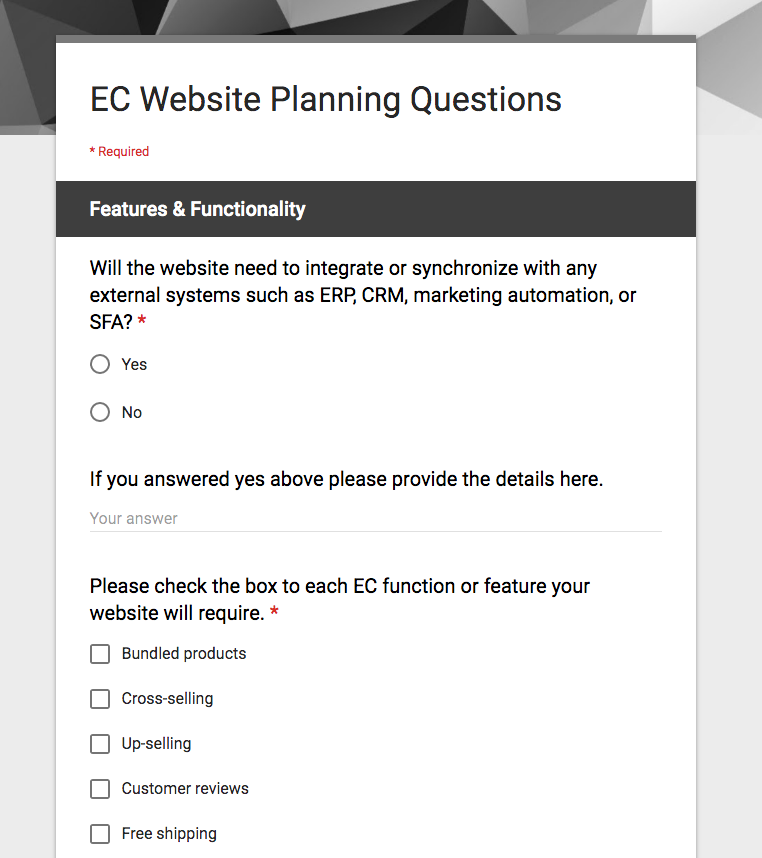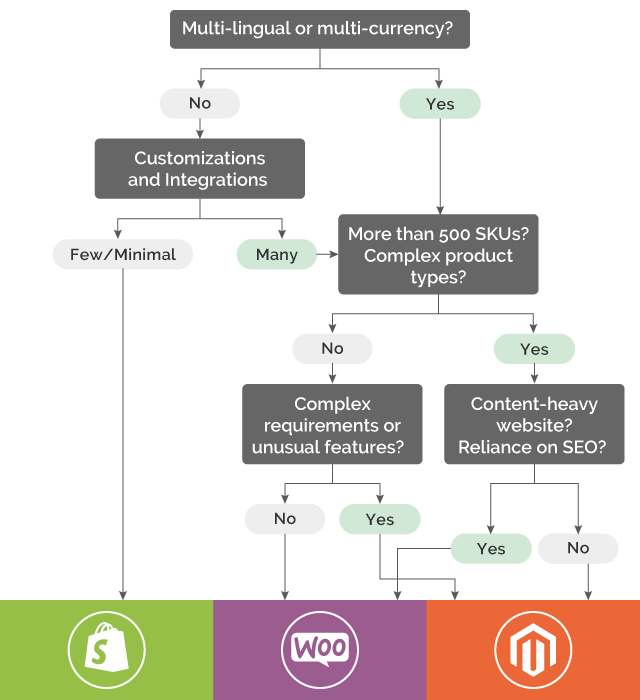Today there are literally hundreds of options available to those looking to launch an online store or other e-commerce (EC) operation. Architecturally you can choose from open-source, self-hosted applications, online marketplaces, hosted Software-as-a-Service (SaaS) solutions, and minimal checkout-only services.
Understanding and evaluating the entire range of options can be a daunting and time-consuming task, and so today I would like to share some recommendations for choosing the optimal platform after the options have been narrowed down to include but three of the most common and widely-used EC platforms available today: Magento, Shopify, and WooCommerce.
While this combination of platforms comprises over 50% of the global market share for EC platforms, it also (and not coincidentally) represents the platforms that we know best and have the most experience with. In other words, the information presented in coming paragraphs draws from our own first-hand experience working with and developing EC websites on these platforms.
At the same time, however, the scope of the article is necessarily narrow. We will not discuss other leading solutions such as Salesforce Commerce Cloud or BigCommerce or any of the many (and largely mediocre) Japanese SaaS offerings. So rather than “comprehensive and objective,” please think of this article as focused very simply on those solutions we know best and use most.
Platform Overview
The three platforms we will look at today each occupy a more-or-less specific niche in terms of their “typical” and/or optimal implementation and business role. Let’s start by covering that niche for each.
Magento
Magento has evolved over the last decade to become one of the world’s leading e-commerce platforms. Available in both commercial and open-source editions, and well-suited to both B2B and B2C implementations, Magento is one of the most trusted and widely used eC-commerce platforms due to its extensive capabilities, functionalities and customization. It supports multi-everything, and is exceptionally well-suited to international deployments incorporating many stores across many regions and currencies. Magento is complex, powerful, and highly customizable.
Shopify
This hosted e-commerce platform has taken the world by storm, and is currently the fastest-growing SaaS EC website builder out there with over 800,000 merchants using the system. Shopify stands out for its ease-of-use, low cost, and rich ecosystem of 3rd-party apps (now numbering over 2800). When compared to other “online store builders” like WiX and Squarespace, Shopify excels through a combination of superior user experience, functionality, and extensions. (For this article we will be looking at Shopify and not their more powerful enterprise offering Shopify Plus.)
WooCommerce
WooCommerce started out as a separate, open-source e-commerce extension for WordPress, but was acquired by the latter’s owner Automattic in 2015. WooCommerce leads the pack in EC platform market share with 21% of the market (December 2018), due in no small part to the dominance of WordPress in the CMS market (now with a staggering 75 million websites running on it).
WooCommerce easily adds online shopping capabilities to WordPress-based websites and is highly customizable. Moreover, an abundance of design themes and extensions make it easy to deploy a fully functional EC website with only moderate technical ability. (Customizing a WooCommerce website, however, requires the support of a skilled developer.)
Which one is right for me?
The three platforms are, for the most part, optimized for different implementation types, and the question of which is best for you is best considered once the requirements have been clearly defined.
Here at Netwise we have a detailed questionnaire we use to collect the requirements details across a wide range of areas, such as features and functionality, audience and market, products, content, post-launch operations, and more.

Based on the responses we receive we are normally able to identify one of the platforms as a good fit for the planned website. Some of the key factors we look at when making this judgement are:
- Languages. Does the website need to support more than one language?
- Currencies. What currencies will the site support, and in which countries will transactions be processed?
- Size. How many products and product variations are there? How much traffic and sales are expected?
- Integrations. What other systems will the website need to communicate with?
- Features. What does the required set of features look like?
These and other factors need to be considered when making a platform recommendation, but very generally speaking we follow these rough guidelines:
- Use Shopify for simple, single-language, single-currency EC websites which will be managed by non-technical operators.
- Use WooCommerce when you have a content-rich website that comprises online shopping functionality alongside a blog, brand content, community areas, news and events, etc.
- Use Magento for medium- to large-scale websites that have one or more multis (languages, currencies, locales, catalogs) or complex products and/or functionality. Magento is powerful and customizable enough to meet even the most demanding set of requirements.
To make the selection process a little easier for folks like you, we prepared a simple decision tree which uses a few basic questions to recommend the optimal platform. It’s simple in its scope, as you can see, but nonetheless highlights some of the key factors that come to bear in the selection process and where they lead outcome-wise.

Budget is also an important consideration when choosing a platform, obviously, and if you’re hoping to build a new EC website for less than 2 million yen you’re pretty much looking at Shopify, or (possibly) a WordPress/WooCommerce website built using a design theme and standard plugins with little customization.
Magento implementations normally start at 3-4 million yen and can easily cost multiples of that, depending on the requirements. As soon as you start adding multis you’ll see the project fee climb quickly, just as you might in cases where extensive customization or integration with external systems are required.
A simple e-commerce website built on WooCommerce and WordPress can run between 2-3 million yen, but for more complex websites that have EC functionality alongside a lot of other content and functionality (e.g. – a content-rich brand website or a reviews-driven online marketplace) the cost can run much higher.
And it doesn’t end with the build.
It’s also important to remember that e-commerce websites–and websites in general–need ongoing support and maintenance. The choice of platform can mean a lot in terms of the type and frequency of post-launch support and technical resources that will be required to keep things running smoothly.
Generally speaking, you can assume the following when it comes to post-launch support and maintenance:
- Shopify has very low technical requirements and is a fully hosted, turnkey EC solution. As a result, software updates and security patches are not something you need to worry about. Similarly, the operation of the website itself is particularly easy and painless, requiring no real technical expertise at all. This makes Shopify a good choice for those without access to technical resources who plan to manage the website themselves.
- WordPress and WooCommerce are certainly more complex than Shopify, but are still user-friendly enough that anyone with experience using WordPress (or other CMS) should have no problem operating and managing the site. However, WordPress and WooCommerce are both open source applications that are subject to regular updates, upgrades, and security patch releases. In some cases these can be applied by a novice, but there is always the risk of breaking your website due to an incompatibility or other issue, and so it is beneficial (and recommended) that you have access to skilled technical resources.
- In the case of Magento you are more or less required to have access to Magento developers, for the same reasons above and for others, too. For example, many “typical” operations like adding new features, applying patches, or configuring the system settings are best not performed by novices. With a Magento website you should plan to have a support and maintenance agreement in place with a Magento-capable solutions provider and budget accordingly.
If you need help with supporting and maintaining your website or online store please have a look at our flexible, affordable website support packages, which are a great way to realize smooth website operations, high availability, and “I’m in good hands” peace-of-mind.
In Conclusion
We’ve covered but three of the many, many EC solutions available today, but the platforms nonetheless represent the bulk of the market, and are each dominant players in their respective niches.
If you’re embarking on an e-commerce website (or mobile) development process and would like help choosing a platform (or technology, or service) we would be happy to talk about how we can help.
In addition to EC website design and development, we also help clients with requirements definition, platform evaluation and selection, and operational and marketing strategy. Get in touch to set up a quick call or meeting, or fill out our short Project Planner from to request a proposal or quote.



